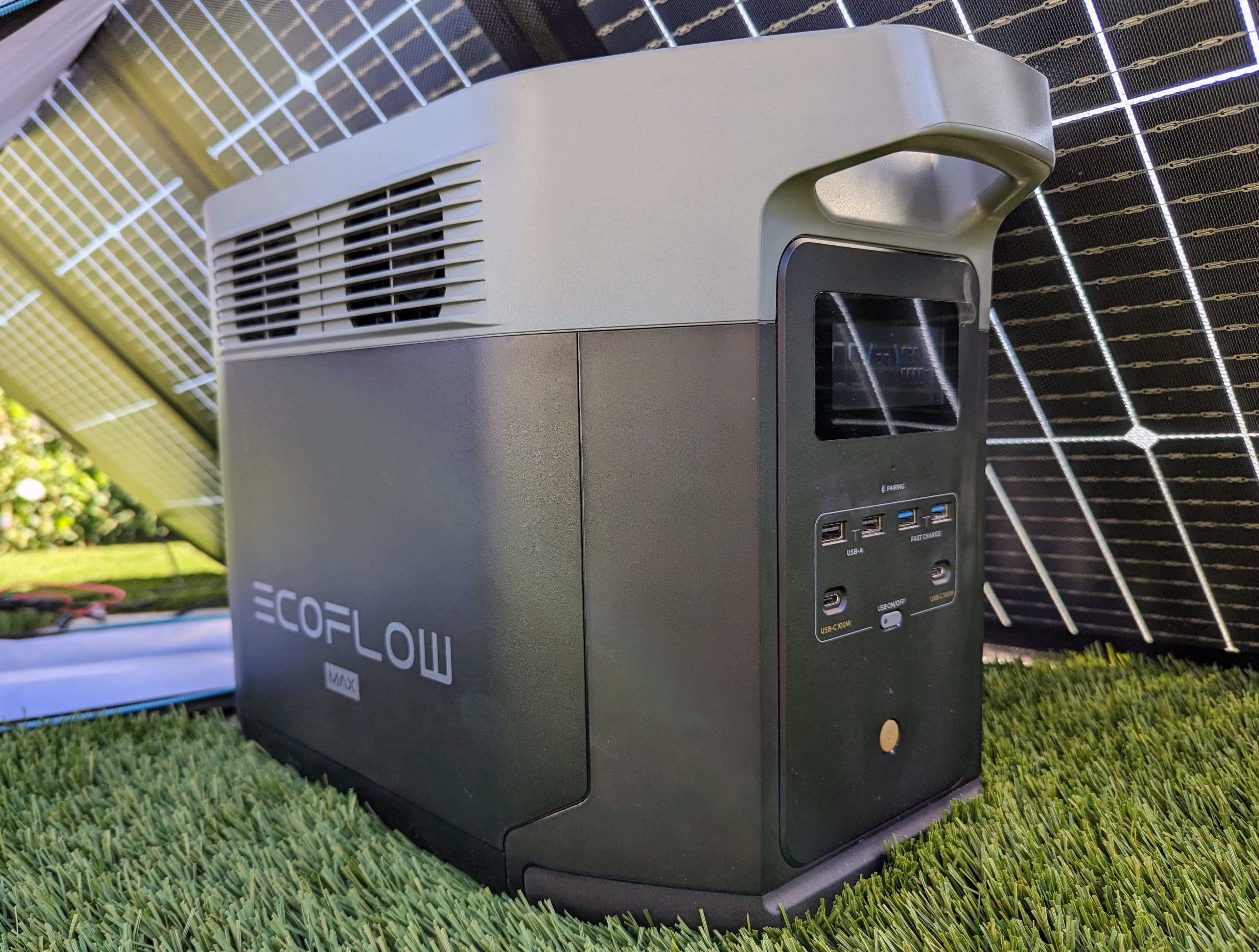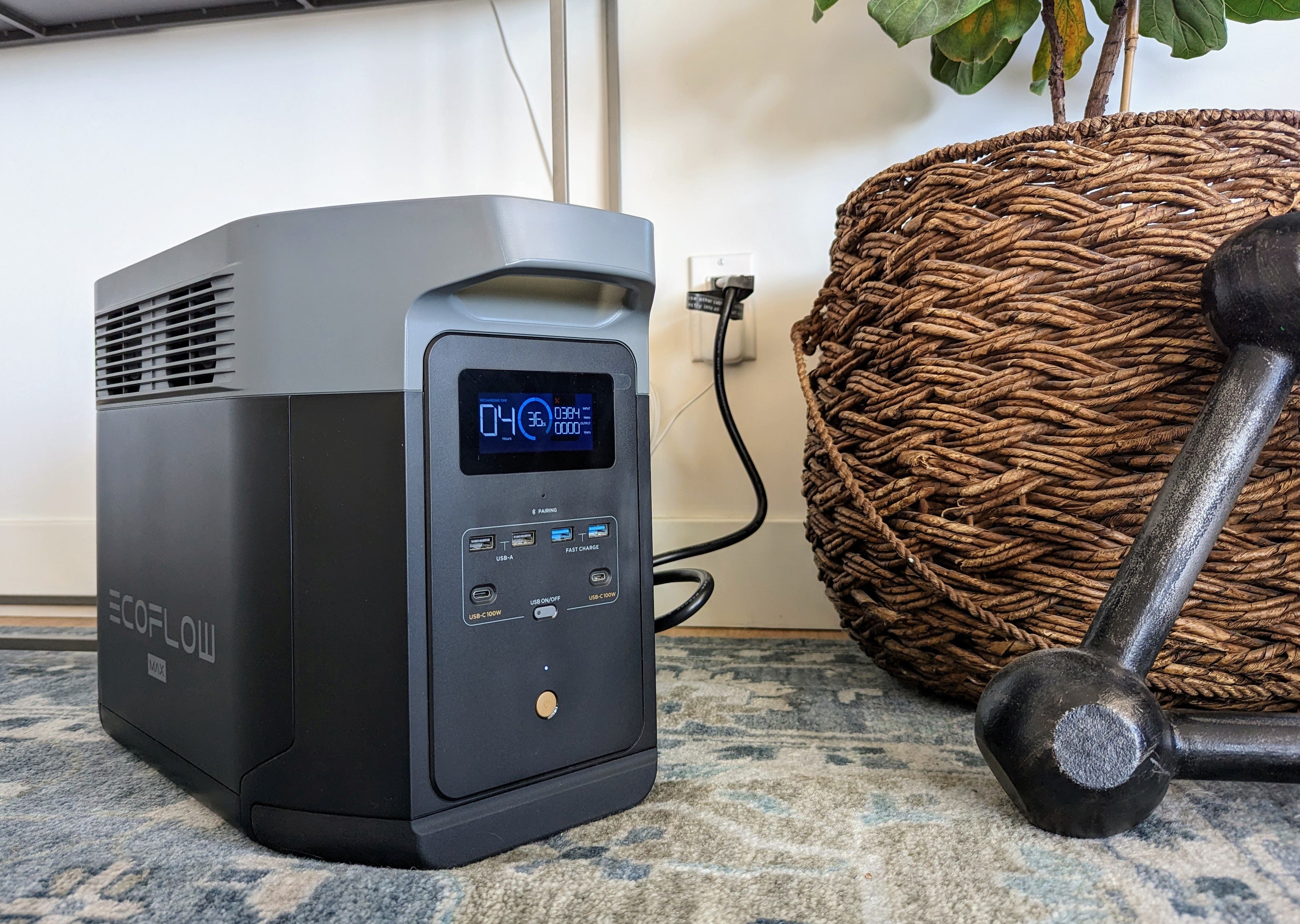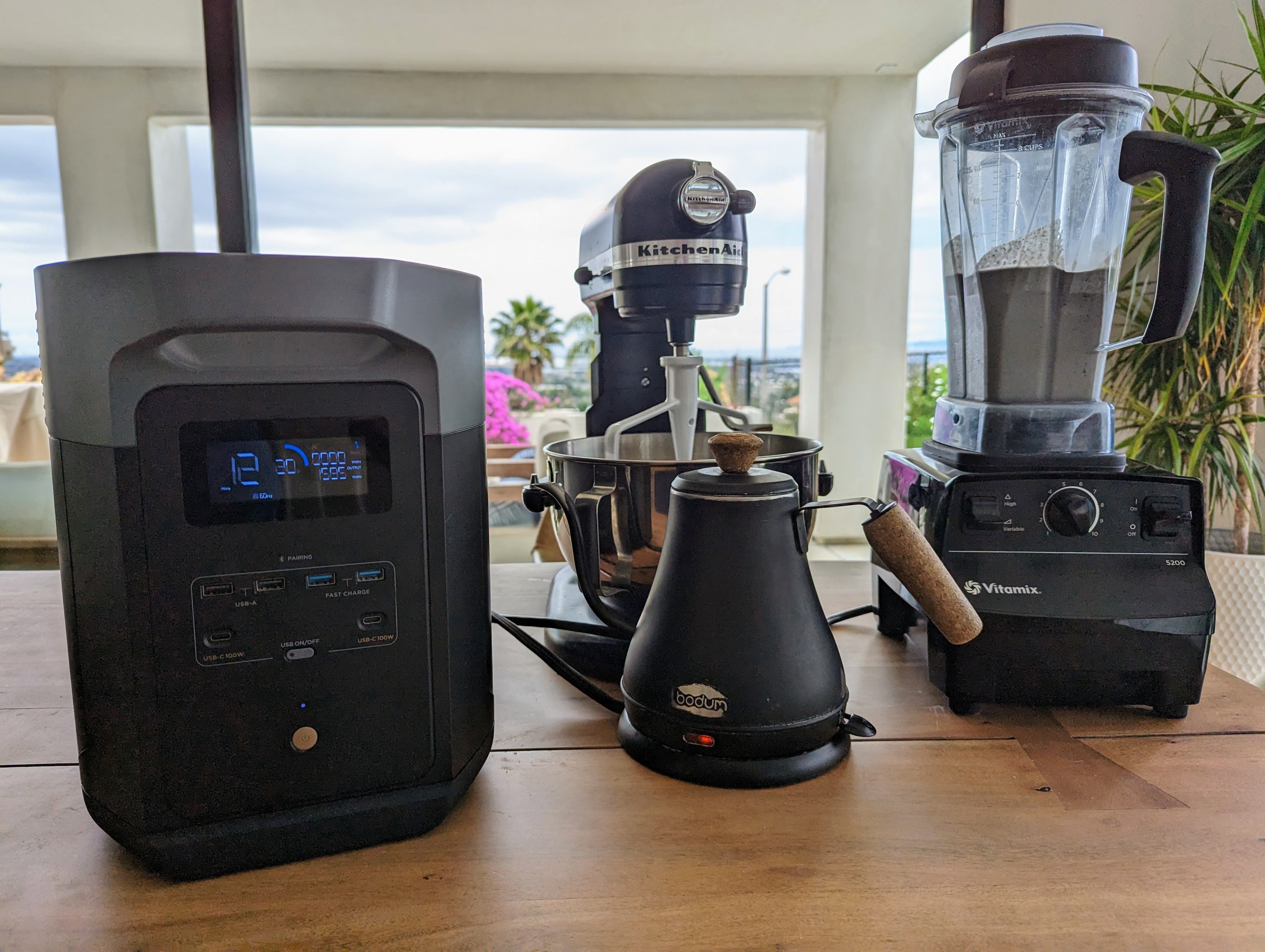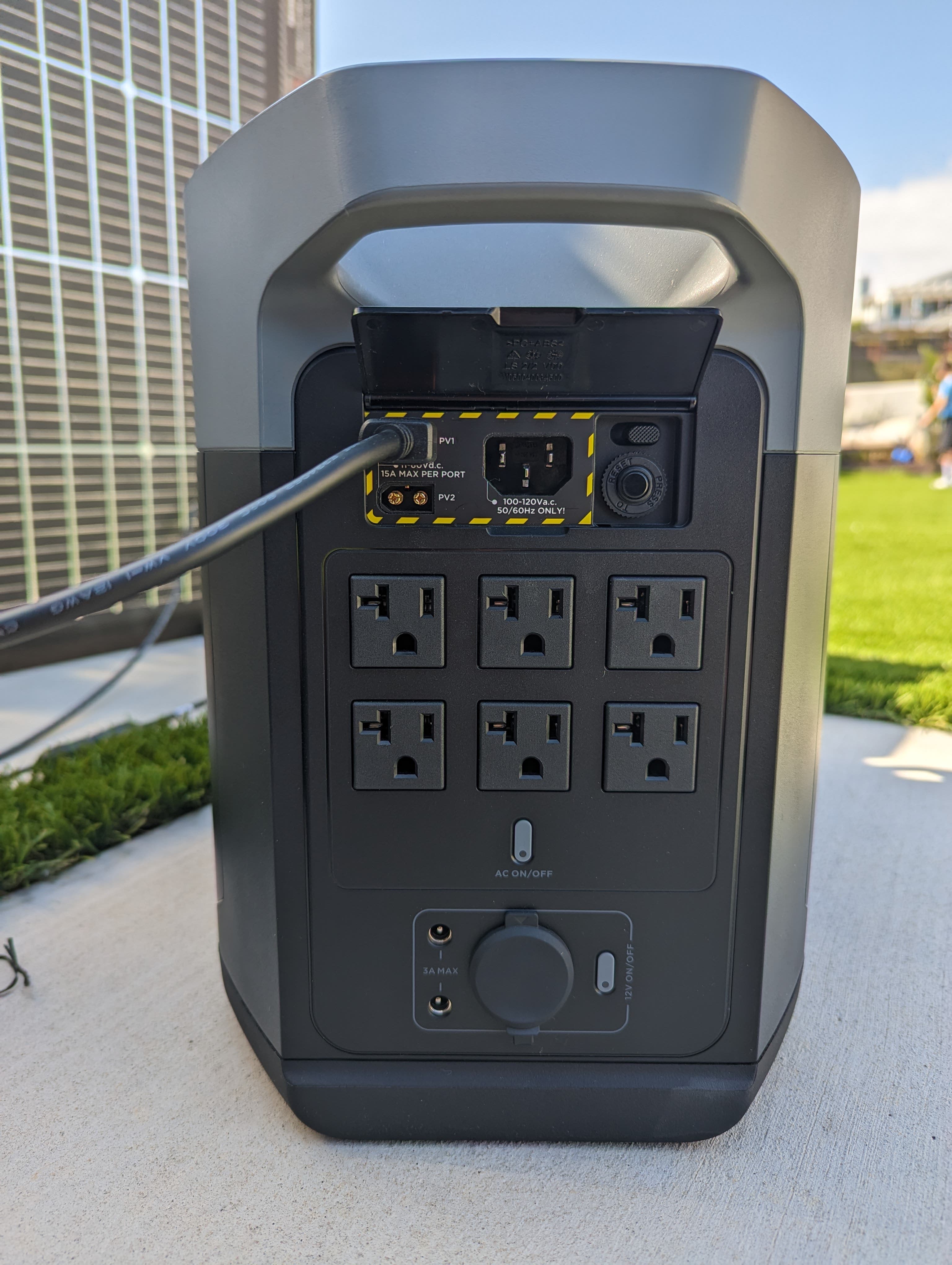
EcoFlow seems to be on ‘a can’t stop, won’t stop’ mission to transform not only the world of portable solar generators, but is also starting to develop a host of appliances that take advantage of these portable power sources.
Following on the heels of a successful lineup of portable power stations and solar panels, EcoFlow has introduced the DELTA 2 Max portable power station. This two kilowatt-hour unit packs a punch with its ability to push out nearly 2,800 watts of continuous AC power output.
We pushed this thing harder than we had pushed any portable power station we’ve tested, and it simply refused to die. With 2,800 watts of AC power output capability, it can easily power just about any appliance in the house, including power tools, 110 volt welders, and EV car chargers, in addition to the usual assortment of refrigerators, cameras, drones, and the like.
Charging The EcoFlow DELTA 2 Max
The EcoFlow DELTA 2 Max is well equipped to pull power in and push it back out again. When plugged into an AC wall outlet, it can absolutely gobble the power down. It features a choice between slow charging at around 400 watts, or fast charging at up to 1,800 watts. Recharging in fast mode translates to about an hour and a half for a full charge, with the charging speed tapering off as the battery pack fills up.
When pulling down 1,800 watts of power at a time, the cables to the wall start warming up, and it’s especially important to be sure you’re using the cable supplied by EcoFlow, as the cables made by mere mortals won’t likely hold up to this amount of power draw for very long.
EcoFlow has also continued to build out its array of solar panel options, and sent along its 220 watt bifacial folding flexible solar panel for us to test. This is the first portable folding bifacial panel we’ve seen, and sandwiches the bifacial solar cells between two layers of clear durable plastic.
Bifacial solar panels still produce the majority of their electricity from sun hitting the top of the panel. This means the panel itself is directional, and as such, it is important to ensure that the side labeled as “sun facing” should be oriented appropriately. This is the side with the wires coming out of it, which is a bit confusing, but the cables have plenty of length to make it work with minimal fuss.

The production of bifacial solar panels improves based on the additional collection surface on the back of the panel more or less, depending on the type of surface they are set up on. Image courtesy: EcoFlow
The back side of the panels harness light reflecting up from the back of the unit. This is helped along by the stand for the panels, which doubles as the padded case for the unit. The inside of the stand is a bright white surface, which helps reflect some of the light passing through the panels and from nearby areas back up to the rear of the solar panel. In our testing we did see production over 200 watts, although it was difficult to achieve on the grassy surface we tested it on. It performed slightly better on lighter colored cement, which is in line with EcoFlow’s estimates in the image above.
Discharging
We spent an entire day using this as the power source for our heat gun as we vinyl-wrapped a car, running the heat gun, music, and our devices off of it. The realization that these portable power stations can not only be used when the power goes out, but also as portable power sources in the home for situations where an extension cord would normally be needed was eye-opening. It almost felt like it was bopping along with the music as we worked. Granted, our heat gun only pulled between 500 and 900 watts, depending on the temperature and throughput volume, but that was just the start.
We ran it through the normal gamut of kitchen appliance tests, ranging from our 800 watt kettle up to the full complement of 1,500 watts worth of blenders, mixers, and kettles, and again it hardly noticed. The EcoFlow DELTA 2 Max boasts 6 AC outlets on the rear of the unit, as well as two 12 volt, 3 amp barrel connectors, and a standard 12 volt automotive outlet. On the front of the unit, four USB-A outlets and two USB-C outlets make it easy to charge all your devices without the need for an extra AC adapter.
We ran a small automotive refrigerator unit from the 12 volt barrel outlet, and pulling between 5 and 55 watts depending on whether the compressor was running or not, the EcoFlow DELTA 2 Max kept up without missing a beat. This is a minor task in terms of output, but mirrors real world scenarios customers will likely use it for.
It’s easy to imagine this unit being put to task as a backup power station for a home. Granted, with just two kilowatt-hours of storage capacity, you’ll need to tightly manage how much power you’re pulling. With 2,400 watts of continuous output and a staggering 4,800 watts of peak power output, this unit would have no issue supporting a compact tiny house or RV setup by itself. Adding in a solar panel or two further extends that capability.
Overall
The EcoFlow DELTA 2 Max is an extremely capable portable power station, though it is a bit on the heavy side at 50+ pounds. That calls into question the portable nature of the unit, though. With something of this size, it’s likely you’re not going to be moving it around a whole lot. That holds true for most large battery systems, as their weight and the relatively fragile nature of the battery cells themselves makes it a good idea to leave them stationery as much as possible.
The EcoFlow DELTA 2 Max is $1,899, which is a slightly higher price than most of the competition in the portable power station space. EcoFlow currently has the DELTA 2 Max on sale and is currently including two 110 watt solar panels free with purchase. That definitely helps the value proposition, but it’s still a premium unit and is priced as such.
For more information about the EcoFlow DELTA 2 Max and the 220 watt bi-facial folding solar panel, head over to EcoFlow’s website.
EcoFlow DELTA 2 Max Specs
- Weight: 23 kg
- Capacity: 2,048 Wh
- Battery Chemistry: LFP (LiFePO4 battery)
- Cycle Life: 3,000 cycles to 80% capacity
- Dimensions: 497 × 242 × 305 mm /19.6 × 9.5 × 12 in
Input
- AC Input: Fast Charge 1,800W, 15A
- DC Automotive Input: 12V/24V battery, 8A
- DC Solar Input: 11-60V 15A, single port 500W; dual port 1,000W
Output
- AC Output: 2,400W continuous, 4,800W peak
- AC Outlets: 6
- DC 5521 Outlets: 2 ports, 12.6V, 3A, 38W Max per port
- USB-A Outlets: 2
- USB-C Outlets: 2
Sign up for daily news updates from CleanTechnica on email. Or follow us on Google News!
Have a tip for CleanTechnica, want to advertise, or want to suggest a guest for our CleanTech Talk podcast? Contact us here.
Former Tesla Battery Expert Leading Lyten Into New Lithium-Sulfur Battery Era — Podcast:
I don’t like paywalls. You don’t like paywalls. Who likes paywalls? Here at CleanTechnica, we implemented a limited paywall for a while, but it always felt wrong — and it was always tough to decide what we should put behind there. In theory, your most exclusive and best content goes behind a paywall. But then fewer people read it! We just don’t like paywalls, and so we’ve decided to ditch ours. Unfortunately, the media business is still a tough, cut-throat business with tiny margins. It’s a never-ending Olympic challenge to stay above water or even perhaps — gasp — grow. So …









